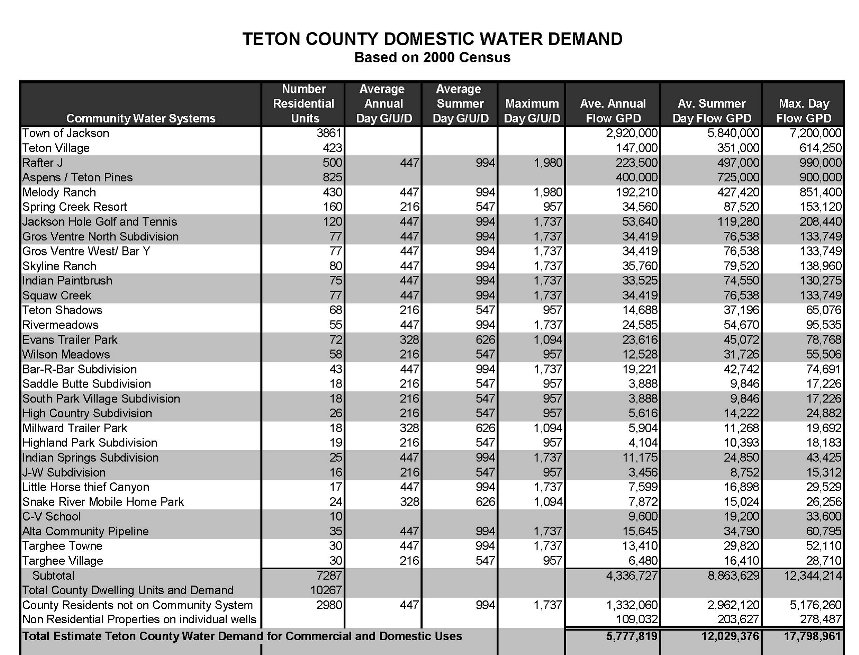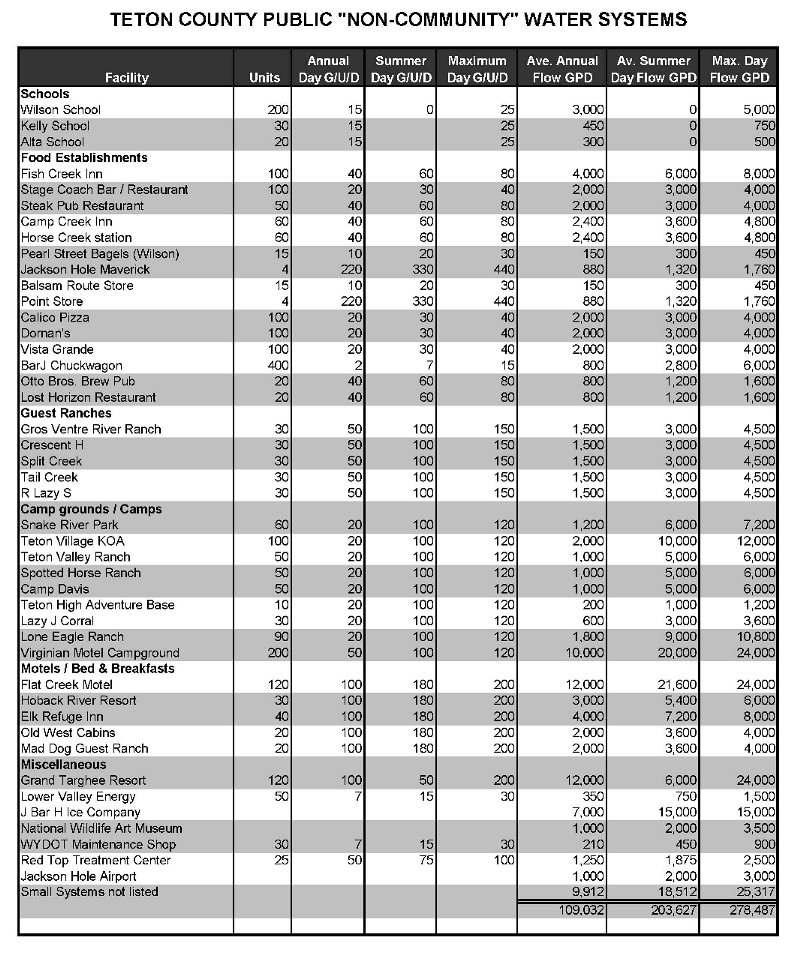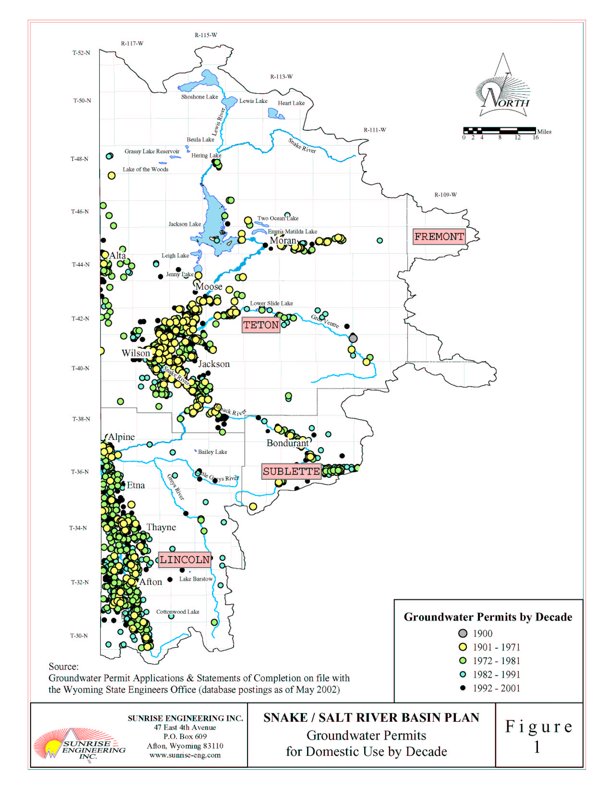Wyoming State Water Plan
Wyoming State Water Plan
Wyoming Water Development Office
6920 Yellowtail Rd
Cheyenne, WY 82002
Phone: 307-777-7626

Wyoming Water Development Office
6920 Yellowtail Rd
Cheyenne, WY 82002
Phone: 307-777-7626



TECHNICAL MEMORANDUM
| SUBJECT: | Snake/Salt River Basin Plan Basin Water Use Profile - Domestic |
| PREPARED BY: | Sunrise Engineering, Inc. |
| DATE: | November 22, 2002 |
Introduction:
Domestic water use consists of the water necessary for the function of residences, subdivisions, ranches, commercial establishments, campgrounds, and so forth. Much of this water is supplied by municipal systems, and this use is addressed in the Basin Water Use Profile - Municipal technical memorandum. Also included in that memorandum are other public community water systems, such as those that serve larger subdivisions and residential areas. This technical memorandum addresses domestic water use in the basin that is not included in the municipal use memorandum.
Methodology:
Prior to determination of the domestic water use in the basin, a distinction between domestic and municipal water use had to be made. In essence, the use of water for domestic and municipal are the same, consisting of residential, commercial, and any other uses that can be served by a municipal water system. While the use is similar, the source of the water and method of supplying that water to the user are not. Municipal systems generally utilize large water supply sources, such as rivers, lakes, wells, and springs. As shown in the municipal use memo, municipal systems in the Snake/Salt River basin consist solely of groundwater from wells and springs. These sources are meant to provide adequate water to the system. On the other hand, domestic sources generally consist of a single well or spring that only has one service connection, or possibly a few connections.
The municipal memo covered public community water systems, which is defined as a system that serves at least 15 connections or 25 people on a year round basis. Many connections, such as those that serve restaurants or schools, may serve more than this number, but are not considered community systems as they do not serve the same people year round. Non-community systems, as well as those that serve individual residences or businesses, are covered in this memo.
In order to determine the extent of domestic use in other river basin plans in Wyoming, the population within a particular basin was obtained. The population served by municipal systems were then subtracted, resulting in the population served by rural systems. A daily water use per capita was then used to determine the water use for this population.
Population Estimates:
According to the Technical Memorandum entitled "Snake/Salt River Basin Plan, Historic and Current Economic and Demographic Conditions", prepared by BBC Research & Consulting, nearly 26,000 people reside in just over 10,000 households within the Wyoming portions of the Snake and Salt River basins. Also, roughly 44 percent of the population of the basin lives within the incorporated boundaries of Jackson, Afton, Thayne, and Alpine. The remainder of the basin's population lives within unincorporated areas of Lincoln, Sublette, and Teton Counties. Table 1 outlines a breakdown of the estimated population in the Snake/Salt River basin, as taken from the above referenced technical memorandum. It must be mentioned that this population data represents year-round residents according to census information.
Table 1. Estimated Snake/Salt River Basin 2000 Population and Related Political Jurisdictions
| Population | |||
| Location | Lincoln/Sublette | Teton | Total |
| Jackson | 0 | 8,647 | 8,647 |
| Afton | 1,818 | 0 | 1,818 |
| Alpine | 550 | 0 | 550 |
| Thayne | 341 | 0 | 341 |
| Municipal Subtotal | 2,709 | 8,647 | 11,356 |
| Unincorporated Areas | 6,623 | 7,970 | 14,593 |
| Basin Total | 9,332 | 16,617 | 25,949 |
Data regarding the populations served by various public community water systems was collected as part of the Technical Memorandum entitled "Snake/Salt River Basin Plan, Basin Water Use Profile - Municipal", prepared by Sunrise Engineering, Inc. This data is summarized in Tables 2 and 3. Note that the population for Jackson and Teton Village differs from the tables in the Municipal memorandum. That document has a population value that includes the large transient population in order to determine water use.
An interesting observation can be made by looking at the population estimates for Teton County. The number of residents served by public community water systems in the county is nearly equal to the estimated full-time population. However, there are a significant number of residences in the county that are not located within the Town of Jackson or the subdivisions served by the mentioned water systems. There is a missing component that is not accounted for in these numbers, and that component is the population that has second or vacation homes in the area. These people are not included in the full-time residence numbers, however they are included in the population served by the various water systems.
Table 2. Snake Sub-Basin Municipal and Domestic Use Units
| TOWN/COMMUNITY | UNITS |
| Alta Community Pipeline | 35 |
| Aspens I/II Water and Sewer District | 825 |
| Bar-B-Bar Subdivision | 43 |
| C-V Ranches | 10 |
| Evans Mobile Home Court | 72 |
| Gros Ventre North Subdivision | 77 |
| Gros Ventre Butte West (Bar Y Estates) | 77 |
| High Country Subdivision | 26 |
| Highland Park Subdivision | 19 |
| Indian Paintbrush | 75 |
| Indian Springs | 25 |
| Gros Ventre Utility Company (Jackson Hole Golf & Tennis) | 120 |
| J-W Subdivision | 16 |
| Little Horsethief Canyon | 17 |
| Melody Ranch | 430 |
| Millward Trailer Park | 18 |
| Rafter J Subdivision H.O.A. | 500 |
| River Meadows H.O.A. | 55 |
| Saddle Butte Subdivision | 18 |
| Skyline Ranch Improvement and Service District | 80 |
| Snake River Mobile Home Park | 24 |
| South Park Village Subdivision | 18 |
| Spring Creek Improvement District | 160 |
| Squaw Creek Water District | 77 |
| Targhee Towne Water Company | 30 |
| Targhee Village | 30 |
| Teton Shadows H.O.A. | 68 |
| Teton Village Water and Sewer District | 423 |
| Town of Jackson | 3,861 |
| Wilson Meadows | 58 |
| Community System Sub-Total | 7,287 |
| Private System Domestic Water Users | 2,980 |
| Snake Sub-Basin Total | 10,267 |
Due to the large number of seasonal residents, use of population figures to determine domestic use would result in erroneous results. According to estimates from Nelson Engineering, some community systems include a significant number of second homes, while others consist of mainly full-time residents. The systems with a significant number of second homes are Jackson, Teton Village, and Aspens. Systems such as Rafter J and Melody Ranch have a small number of second homes. According to the technical memorandum entitled "Snake/Salt River Basin Plan, Future Economic and Demographic Scenarios", approximately 30 percent of Teton County's housing inventory is seasonal homes. As a result, it is not possible to simply subtract the number of residents served by the above systems from the total population of the sub-basin to obtain the rural population.
Instead of using population to determine the domestic water use in the Snake River sub-basin, it was decided to use the number of households. This is possible since the census data has information regarding households in the sub-basin as well as the number that were vacant at the time of the census in April. The resulting numbers would generally represent the full time residents, as April is considered off-season in the area. By utilizing this information, it was possible to estimate the number of residences in the Snake River sub-basin that are not obtaining water from community systems. This way, the use of water can be calculated for both tourist season and off season. Also, data regarding commercial establishments not connected to community systems were collected. This covered uses for schools, food establishments, guest ranches, campgrounds, motels, and other uses. These uses were added to the rural residential uses to result in the domestic water use. A detailed breakdown of domestic water use in the Snake River sub-basin can be found in Appendix A. From this data, approximately 2,980 residences obtain their water from small or individual systems, along with various commercial establishments.
Table 3. Salt Sub-Basin Municipal and Domestic Use Population
| TOWN/COMMUNITY | POPULATION |
| Town of Afton | 1,640 |
| Town of Alpine | 288 |
| Bedford Water and Sewer District | 560 |
| Etna Water & Sewer District | 85 |
| Fairview Water & Sewer District | 360 |
| Freedom Water and Sewer District | 120 |
| Grover Water and Sewer District | 280 |
| Happy Valley Pipeline Company | 60 |
| Kennington Springs Pipeline Company | 63 |
| Nordic Ranches Subdivision | 180 |
| Osmond Community | 200 |
| North Alpine Special Service District | 40 |
| Smoot Water & Sewer District | 500 |
| Star Valley Ranch Association | 1,800 |
| Star Valley Ranch RV Park/Bridger View Ranches | 900 |
| Star Valley Trailer Court | 100 |
| Town of Thayne | 318 |
| Westview Village | 70 |
| Willow Creek Pipeline Company | 50 |
| Community System Sub-Total | 7,564 |
| Private System Domestic Water Users | 1,768 |
| Salt Sub-Basin Total | 9,332 |
While there are part-time residents in the Salt River sub-basin as well, their iMpact on water use is not as dramatic as that in the Snake River sub-basin. Many seasonal residents leave only during the winter months, although the time of their absence varies greatly. Some will leave from October to May, while others only leave for January and February. While the number of part-time residents in the Salt River sub-basin is unknown, it is believed that a majority of the seasonal residents that leave for the winter are located in the Star Valley Ranch area, including the Star Valley Ranch RV Park. The number of residents in both summer and winter are known for these areas, so it is possible to use population as a basis to determine domestic water use. As shown in Table 3, approximately 7,564 of the 9,332 living in the Salt River sub-basin area are served by community systems. That leaves 1,768 people served by domestic use systems.
Water Use:
Water use in the unincorporated portions of the basin can be quite variable. For example, a residence may have a well that provides for indoor use. Additional uses may be lawn and landscape irrigation, which may be many times the indoor use. Some may run water for horses or cattle, which may be constantly running month after month. Faucets may run to prevent freezing during winter. The various uses means that the actual water use may be quite variable from person to person. Also, methods of billing can influence water use, as those billed by water use will likely use less than those with flat rates. Also, people obtaining their water from a well may be more conservative in their water use to reduce power costs compared to those served by a spring. As this is a basin wide study, a daily per capita use has been determined that will likely serve as an average for domestic users in the basin.
Domestic use water rights have been reviewed as part of this basin plan. Generally, domestic water is served by wells, which will be permitted for a particular flow rate in gallons per minute (GPM). In reality, this flow rate is the maximum that will be pumped at any given time, and is only realized when the pump is in use. The pump will sit idle the majority of the time, and will only kick on to serve water needs. Many systems will utilize a tank of some type to minimize the number of starts required for the pump, thus reducing wear and tear on the pump. For example, a pump for a residence may be permitted to run at 5 gpm, which could result in 7,200 gallons per day. However, a typical residence may only use 500 gallons per day. Thus, a compilation of water rights by permitted flow rate is not particularly meaningful. However, domestic wells in the basin are shown in Figure 1, and this data is available in the GIS coverage.
After reviewing the water use on the community systems in the basin, as well as various studies on water use in the basin, it was determined by the project team to use an average daily water use of 450 gallons per residence. This rate appears to be a good average when looking at the factors affecting use described previously. A summary of the average daily domestic water use in the basin is presented in Table 4.
Table 4. Average Daily Domestic Water Use by Sub-Basin
| SUB-BASIN | RESIDENTIAL USE (GPD) |
OTHER USE (GPD) |
TOTAL USE (GPD) |
| Salt | 800,000 | Included w/ residential | 800,000 |
| Snake | 1,332,000 | 109,000 | 1,441,000 |
| Basin Total = | 2,241,000 |
Additional data regarding domestic water use in the basin can be
found in Appendix A.
Appendix A


Groundwater Permits For Domestic Use By Decade - Figure 1

References:
BBC Research & Consulting, Snake/Salt River Basin Plan, Historic and Current Economic and Demographic Conditions, 2002.
Sunrise Engineering, Inc., Snake/Salt River Basin Plan, Basin Water Use Profile - Municipal, 2002.